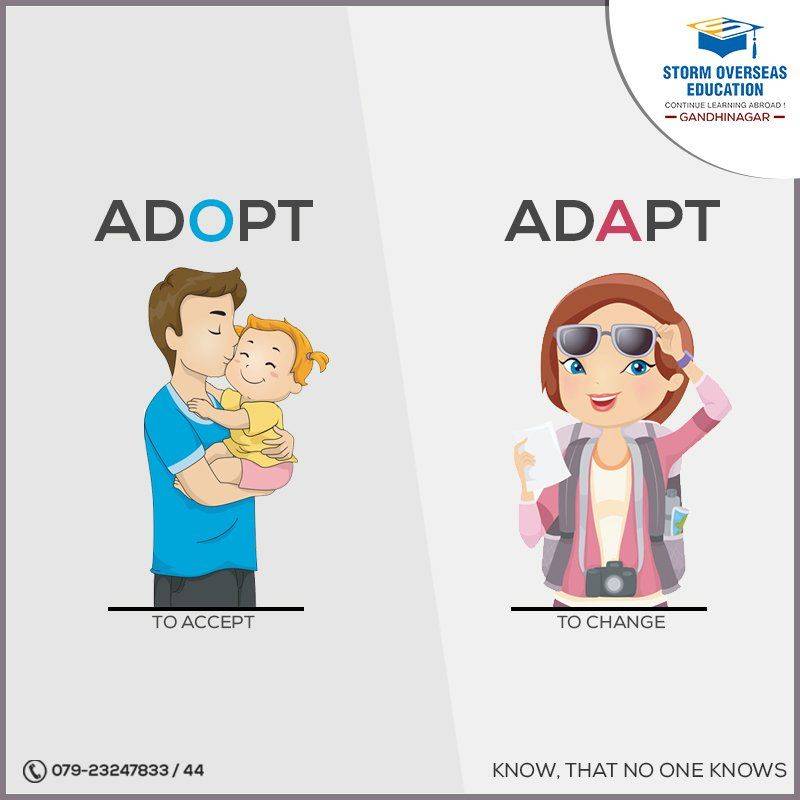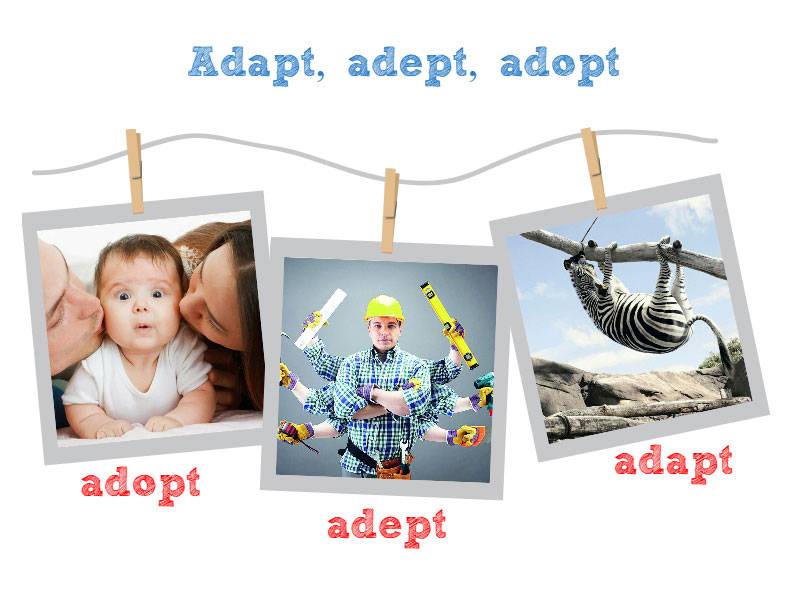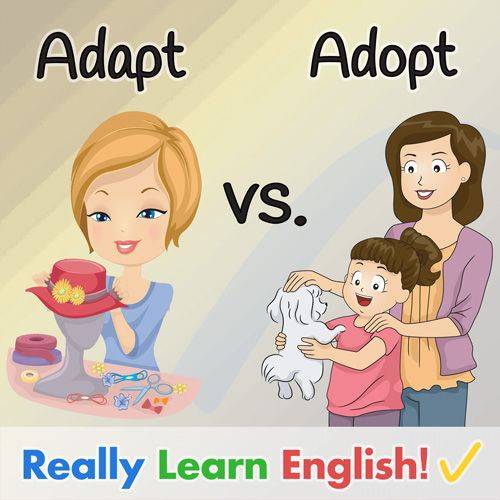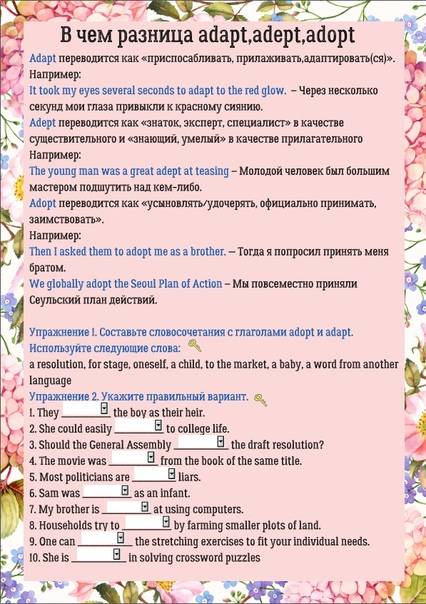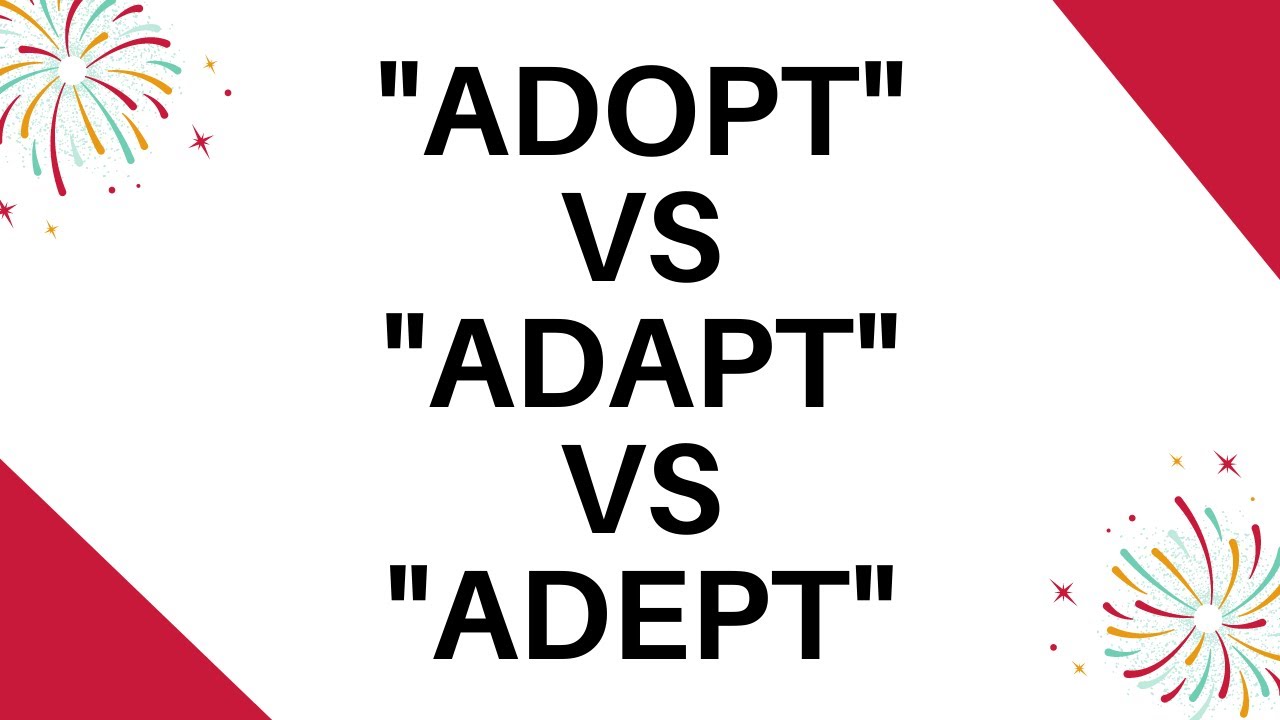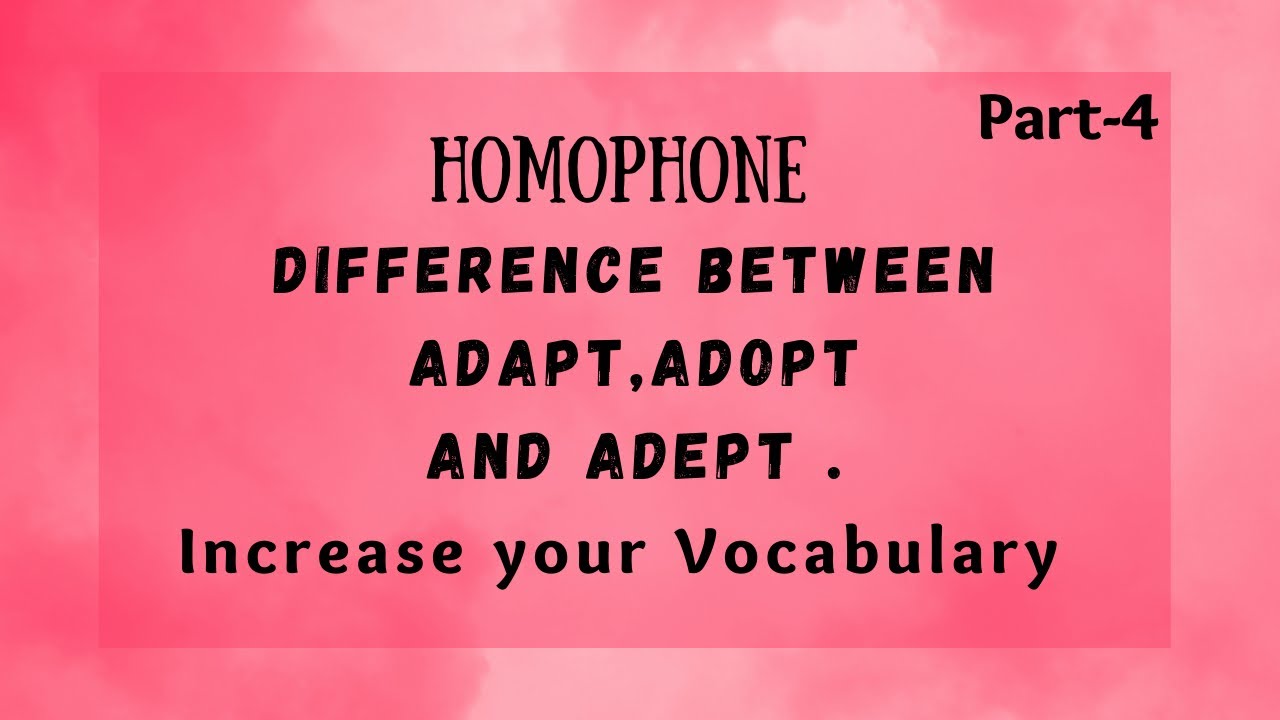Adapt
The word adapt has three definitions, all related to change. The first definition is used to talk about things. When we say that we adapt something, we mean that we alter or change it in a small way.
The second definition is used to talk about people. When we say that someone adapts him or herself, we mean that the person is changing, adjusting or getting used to a new situation or circumstance.
This definition can also be used to talk about companies and organizations. When companies and organizations change or adjust to something new, they are also adapting.
Finally, adapt means to change a book or text and make it suitable for a TV program or movie. These days, many movies are adapted from novels.
The noun of adapt is adaptation. Something that is capable of adapting is adaptable, whereas something that is not capable of adapting is not adaptable or unadaptable.
What’s the Difference Between ‘Adopt’ vs ‘Adapt’?
The obvious difference between these two words is their one-letter change, but what does that tell us about these words? Let’s first look at their origins.
Both ‘adopt’ vs ‘adapt’ use the Latin prefix ‘ad-’ which means “to.” Since those are the same, we can look at their roots/suffixes to identify a difference.
- The root of ‘adopt’ is the Latin ‘optare’ which means “choose,” kind of like the word “option.” You can use the root to remind you that ‘adopt’ means to choose or have options.
- Meanwhile, the root of ‘adapt’ is ‘aptare’ which comes from ‘aptus’ meaning “fit.” When something ‘adapts’ it fits into a new place or circumstance, so use the root as a reminder of that.
Of course, if one is easier to recall than the other, you can memorize one and then use the process of elimination. But this way, you have an understanding of where each word came from. Similarly to using the roots as reminders, you can also use other spelling hints.
The word ‘adapt’ starts similarly to its synonym ‘adjust.’ You can use the first two letters “ad-” as a context clue in that case.
Be careful not to combine that with the first two letters of ‘adopt.’
Meanwhile, remember that ‘adopt’ has an ‘o’ in it, just like the word “choose,” which you can use as a hint to its meaning.
Yet, while all of this is helpful, it doesn’t give us a full picture of the individual meanings of each word. Let’s look closer and dive into the definitions of ‘adopt’ vs ‘adapt.’
When to Use Adapting vs. Adopting
When it comes to choosing between adapting and adopting, it can be challenging to know which one to use. In this section, we’ll explore some of the particular use cases and English language usage to help you decide which one is most suitable for your needs.
Particular Use Cases
Adapting is often used when there is a need to modify something to make it more suitable for a particular purpose or condition. For instance, if we are moving to a new city, we might need to adapt to the new environment, culture, or weather. In contrast, adopting is used when we take over or choose something that is already available or existing. For example, we can adopt a new policy, practice, or approach.
In some cases, we might need to use both adapting and adopting. For instance, when we are implementing a new policy in a different environment, we might need to adapt the policy to suit the new conditions and then adopt it as our own.
English Language Usage
In the English language, adapt is a transitive verb, which means it needs an object to complete its meaning. For instance, we can say “We need to adapt our strategy to the new market conditions.” In contrast, adopt can be both transitive and intransitive. For example, we can say “We need to adopt a new approach” or “We need to adopt to the new conditions.”
It’s worth noting that adapt is often used in the context of modification or change, while adopt is often used in the context of choice or acceptance. Therefore, when we want to emphasize the idea of modification or change, we might use adapt, and when we want to emphasize the idea of choice or acceptance, we might use adopt.
Conclusion
In conclusion, the decision to adapt vs adopt in the realm of software and systems hinges on various factors including business strategy, cost, risk tolerance, and the specific needs of the end-users. Adapting involves refining and enhancing existing systems to meet new challenges, while adopting is about embracing new technologies, often revolutionizing the way an organization operates. Both strategies have their place in the technological landscape, and the choice between them should be informed by a thorough analysis of an organization’s goals, resources, and the demands of the market it operates in.
Understanding the nuances between adapting and adopting is crucial for any business or individual working with software and systems. It guides decision-making processes, influences development paths, and ultimately shapes the technological future of the organization. Whether it’s adapting to incrementally improve or adopting to make significant leaps forward, the key is to align these strategies with overarching objectives and the ever-evolving landscape of technology.
Why work with Innovation Unit on ‘adopt and adapt’?
Innovation Unit has developed our adopt and adapt methodology over many years, and learned hard lessons from experience of applying this approach in different places, systems and sectors. In particular we are grateful for all that we have learned from working alongside our partners and clients on a range of different programmes.
We have developed a range of tools and resources to help the adopt and adapt process. We know how to ‘hold’ teams adopting innovation through difficult, and daunting change. We also work hard to keep everyone enthused to meet their original aspirations. We support adopters to make a compelling case for change, develop their theory of change, and identify the outcomes and indicators to use in evaluation. We support adopters to coproduce their new model with their local communities, and design, test and prototype their adaptations before implementing at scale. Our team also provides a proper two-way partnership, acting as facilitators, coaches and critical friends.
What do we mean by adopt and adapt? Part One
By Stuart Rance on October 20, 2015 at 11:04 AM in ITIL, ITSM, adopt, adapt
I suspect that every ITIL training course uses the phrase “adopt and adapt” at some stage, but sadly I see very little understanding of what this phrase means. This lack of understanding often results in people trying to use the ideas from ITIL publications in a very bureaucratic way, imposing them indiscriminately and without due regard to the business context. It’s hardly surprising that this results in dissatisfaction from both IT staff and customers of the IT service.
ITIL publications all include the line “Organizations are encouraged to adopt ITIL best practices and to adapt them to work in their specific environments in ways that meet their needs.”, but they don’t give much in the way of advice about how to do this. How do you decide which ideas to adopt? And how do you set about adapting them? Over the course of the next two blogs I’m going to share my suggested approach with you.
Как адаптируют страницы?
Есть несколько вариантов адаптации сайта (на самом деле как таковой классификации нет, разделим сами).
1. Фиксированная вёрстка
Это подход, когда все элементы сайта имеют фиксированную ширину. С какого бы устройства мы ни зашли, сайт всегда будет выглядеть одинаково. Соответственно, если элемент не поместится в экран, то появятся полосы прокрутки.
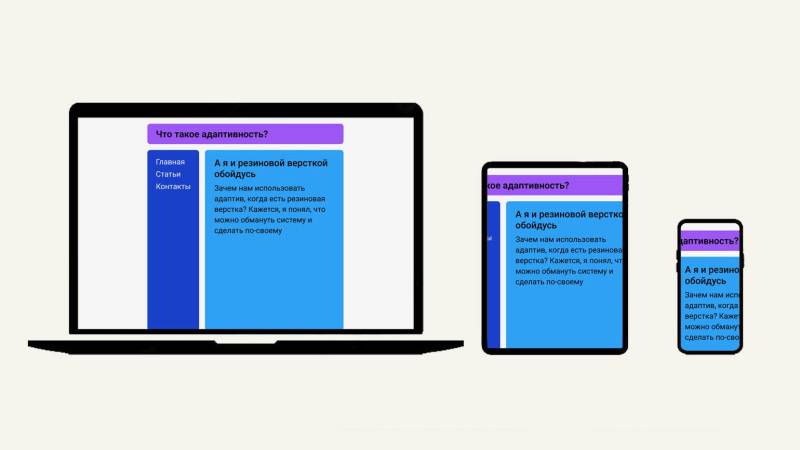
Изображение: Мария Черноскулова
Сейчас это уже пережиток прошлого, когда мониторы имели фиксированные популярные разрешения 800×600 или 1024×768.
Задаётся банально в CSS свойством width: 500px.
2. Резиновая вёрстка
Элементы на странице остаются на своих местах, но при этом тянутся (как резина) либо сжимаются в соответствии с шириной экрана. Им задаётся относительная ширина, например в процентах width: 100%.
Всё бы ничего, но обычно в итоге при определённой ширине экрана мы получим вот такой результат. Выглядит некруто:
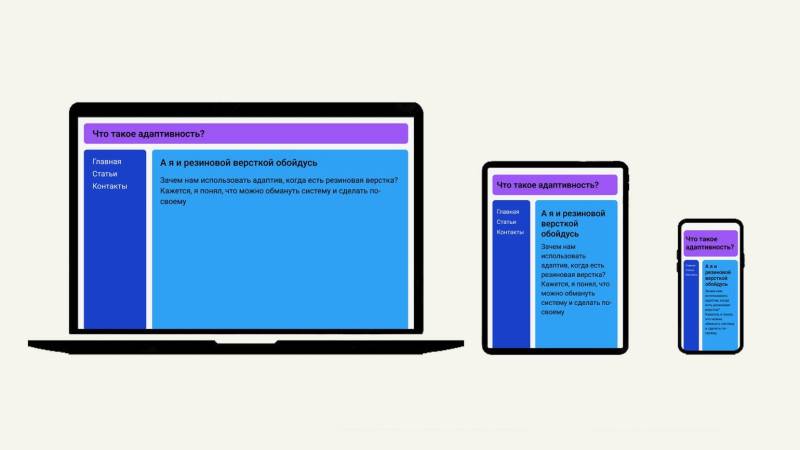
Изображение: Мария Черноскулова
И вообще, сверху показан маловероятный результат. Обычно в итоге мы получаем это. Выглядит совсем некруто. Нам не подходит:

Текст банально не помещается в блок и вылезает за его пределыИзображение: Мария Черноскулова
Это тоже устаревший способ, который сейчас не используется в чистом виде, но знать о нём нужно.
3. Адаптивная вёрстка

Изображение: Мария Черноскулова
В основе — медиазапросы, указанные в CSS.
Ширину элементов при этом задаём фиксированно.
Если простыми словами, то наша страница трансформируется (как бы прыгает), когда мы преодолеваем эти точки, перестраивая контент на новый лад, описанный в CSS. В итоге мы получаем набор фиксированных макетов для каждого промежутка.
Quiz
Answer the following 10 questions and then check your answers. Each question is worth 10 points.
Part 1:
- Which of the following is NOT a correct definition of adapt?
- To change
- To get used to
- To raise a child
- To alter
- Which of the following is a correct definition of adopt?
- To take in a child
- To change a book for TV
- To get used to
- To adjust
- Which sentence is written correctly?
- I don’t like the new adoption of Cinderella.
- My children have been asking me to adopt a pet.
- It will take some time for Rachel to adopt to her new job.
- We are going to adopt the garage for use as a studio.
- Which sentence is written incorrectly?
- Pride and Prejudice, by Jane Austen, has been adapted for TV several times.
- It was difficult for Maria to adapt to life in a new country.
- The company decided to adopt a new policy.
- Pablo’s family is thinking of adopting to a baby.
Part 2:
- Which of the following is true about adapt and adopt?
- They are pronounced the exact same way.
- Their meanings are very similar.
- The two words are both verbs.
- The two words are both nouns.
- Which of the following is NOT true about adapt and adopt?
- They both mean to take in and raise a child.
- They have very different definitions.
- They are pronounced differently.
- The two words are both verbs.
Part 3:
- Couples who cannot have children often think about ____________.
- adapting
- adopting
- adapted
- adopted
- We ____________ part of our living room for use as a dining area.
- adapted
- adopted
- adapted to
- adopted to
- It will be difficult to ____________ not having a car.
- adapt
- adopt
- adapt to
- adopt to
- The new rule ____________ the company is quite unpopular.
- adapted by
- adopted by
- adapted to
- adopted to
What Is The Difference Between Adopt vs Adapt?
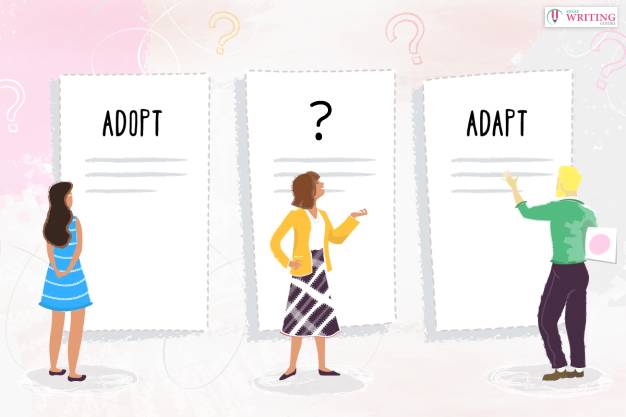
In my article, you will get the absolute difference between the two words to adopt vs adapt. You must know specific facts that can help you make things work well your favor. Proper in-depth knowledge of the two words can illustrate the essential points of difference between the two words.
1. Meaning
If you are getting confused between the two words – adopt vs adapt, and dont know which word you should use in which situations, then understanding the basic meaning of the words may help. When you are adjusting something or modifying something so that it becomes more suitable for a specific situation or a purpose, then it is Adapt.
On the otherhand, when you accept something as your own, it is known as adopt.
The two words may sound similar, but their meanings are far apart.
The adapt vs adopt meaning is entirely different from one another.
You need to understand it in detail to make things work well in your way. Then, you need to make your selection with ease at the right point in time.
2. Verb Type
Adapt is used as both the transitive and intransitive verbs. This means that it can be used torefer to a direct or indirect object. On the otherhand, the word ‘adopt’ is only used as transitive verbs, which means that the word is used only to refer to a direct object.
You need to know these facts at your end while you make the differences between the adopt vs adapt.
You have to understand the facts that can help you make the perfect use of these two words while you are framing the sentences at your end.
Do not mix up the two concepts from one another to achieve your goals effectively.
Proper application of the words in a sentence can help you achieve your objectives appropriately.
3. Number Of Meanings
There are a total of four types of meanings for the word adopted. Let’s get into the details to know more.
- Legal process of bringing home someone else’s child.
- Getting an animal from rescue or an animal shelter.
- If you want to take over some things as one’s own.
- When a rule, method, policy, or suggestion is being formally accepted and implemented.
- When someone is assuming a particular tome or behavior.
There are specific crucial three points of difference in the case of adapting. Some of them are as follows:-
- When someone is changing or modifying something to make it more suitable for a particular use.
- When someone is adjusting to a new situation or a place.
You need to understand these three core factors to make things work well in your favor.
4. Collocations
When the word adopts is used, there is no need to use any preposition after it. On the other hand, when you use the word “adapt,” then preposition after it. For example, they have adapted to the situation.
You need to know these factors while you want to use these two words on your end. It can make or break the meaning of any sentence. So you have to understand these factors on your end.
5. Examples
With the help of specific examples, you have to understand certain factors which can make things easier for you within a stipulated period.
- Hercules & Elizabeth wants to adopt a child from France.
- Indian Soldiers have adapted to the situation very well.
- If you cannot adapt to the situation quickly, then it will become difficult to survive.
- Emperor Ashoka adopted Buddhism after the Kalinga war.
- I always adopt healthy eating habits for my well-being.
- He decided to adopt Sam and raise him as his child.
- I adapted myself to the new work environment very quickly.
- The wicket became more difficult to play on and he adapted beautifully.
- Academics also benefited from the opportunity to adapt their teaching methods to a new environment.
- Parliament adopted a resolution calling for the complete withdrawal of troops.
- My first desire was to learn the language of my adopted country as soon as possible.
Examples
- Bill and Linda weren’t able to have any children of their own, so they decided to adopt. (Bill and Linda had trouble having a baby, so they decided to take in a child in need.)
- In my family I have one biological sister and one adopted sister, but I love them just the same. (I have two sisters. Only one is my biological sister, but I love them both equally.)
- So many dogs are in need of good homes. So instead of going to the pet store, we decided to adopt a puppy from the shelter. (Instead of buying a puppy at the pet store, we took in a puppy that had been on the streets.)
- My company has decided to adopt a new policy. Now, when people arrive late, they have to pay a fine! (My company has put in a new rule. Now, people who are late have to pay for it!)
- The government decided to adopt the committee’s recommendations. (The government accepted the recommendations from the committee.)
Что было до адаптивности в вебе
Если вернуться на много лет назад, когда трава была ещё зеленее и небо голубее и… Короче, когда интернет только появился, у нас, по сути, были только ПК с примерно одинаковыми дисплеями, и сайты разрабатывались только для них. Ни о чём больше не надо было думать: ни JS ещё не было, ни React… Были же времена. Было круто! (Нет.)

Mail.ru в 2000-м выглядел так. Тогда это ещё была почтовая службаИзображение: mail.ru / Habr
Но в начале 2000-х активно начал набирать обороты мобильный интернет, и люди стали выходить в Сеть с мобильных телефонов. Что думаете, как отображался сайт на экране мобильного телефона, который разрабатывался исключительно для десктопа? Правильно: криво, нечитаемо, приходилось постоянно скроллить вправо, влево.
После этого разработчики задумались над адаптацией контента сайта для разных устройств, чтобы везде всё было читаемо и красиво.
Final Take Away
Hence, these are some of the crucial factors that you must know at your end when you want to make the distinction between the two concepts, “Adopt vs Adapt.” You need to apply the concepts as per the needs of the sentences.
You need to know the concepts well to make things work well in your way. So ensure that you know the tricks to use these two words correctly to make things work well in your way.
Feel free to share your concepts, ideas, and views on this matter before you use these two ideas. Avoid making things too complex while you want to make the perfect use of these two sentences.
Read more…
- Compare and contrast outline: Follow 5 essay steps to write a compare and contrast outline.
- Child Care Leave Application – Things You Should Know.
- “Principal vs Principle” – When to use these two words?
What is the meaning of warm embrace?
verb. If you embrace someone, you put your arms around them and hold them tightly, usually in order toshow your love or affection for them.
Is embracement a real word?
A ready taking up of something: adoption, espousal.
What does umbrage mean in English?
1 : a feeling of pique or resentment at some often fancied slight or insult took umbrage at the speaker’s remarks. 2 : shady branches : foliage. 3 : shade, shadow.
How do you embrace?
10 Ways to Embrace Change
- Don’t just do something; sit there.
- Mother yourself a little.
- Ignore your inner reptile.
- Silence your inner know-it-all, too.
- Seek out new perspectives.
- Try something new and slightly scary.
- Be skeptical of common wisdom.
- Learn to live with uncertainty.
How do I embrace my true self?
Here are some strategies to help us embrace and love our “true” selves:
- Identify what you LIKE about YOURSELF.
- Identify what you LOVE about YOURSELF.
- Identify where YOU want to be in YOUR life.
- Just say no!
- Stop comparing yourself to others!
- Make good self care activities a priority daily!
How do I embrace who I am?
“Love yourself. Forgive yourself. Be true to yourself. How you treat yourself sets the standard for how others will treat you.”―Steve…
- Know Yourself.
- Stop Criticising Yourself.
- Embrace Your Positive Nature.
- Acknowledge Your Success.
- Release Your Worries.
- Forgive Yourself.
- Be Grateful.
How do you embrace change in a positive way?
6 Ways to Embrace Change Positively
- Acknowledge the change. Don’t brush things under the rug.
- Look at the situation optimistically.
- Don’t stress out about stressing out.
- Analyze your values as opposed to your fears.
- Share your thoughts with others.
- Be flexible and embrace change.
Как реализовать адаптивную вёрстку?
Обычно мы используем переменные (это примерные цифры, я решил их использовать для наглядности. В любом случае они подбираются конкретно под вашу задачу, а не возникают с неба):

Изображение: предоставлено Олегом Рязанцевым
Задаём адаптивность следующим образом (CSS code, если его можно назвать словом code ):

Изображение: предоставлено Олегом Рязанцевым
Данной записью мы говорим, что свойство width: 600px для класса .myClass применится, только если ширина экрана будет меньше или равна 768 px. Во всех остальных случаях она будет равна 900 px.
Также можно наоборот:

Изображение: предоставлено Олегом Рязанцевым
Свойство width: 900px для класса .myOtherClass применится, только если ширина экрана будет больше или равна 1024 px.
Важно не перепутать больше или меньше, но обещаю, что придётся это проверить не раз, таков путь
Вы можете комбинировать условия, а ещё почитать документацию и изучить тему более подробно.
Отмечу: эти свойства применяются не только к ширине экрана устройства, но и к ширине окна браузера, что вполне логично.
Откройте любой сайт в браузере (почти любой, почему «почти», узнаем ), желательно — одностраничный лендинг. Захватите левой кнопкой мыши правый или левый край окна браузера и попробуйте увеличить или уменьшить размер окна. Вы в реальном времени увидите, как сайт будет перестраиваться по брейкпоинтам.
Поиграли? Тогда идём дальше.
Зачем мобильную и десктопную версии собирают отдельно
Вышеописанный метод неплох для небольших приложений, но представьте, что у вас большое.
Каждый раз, заходя на сайт, вы будете подгружать стили и элементы для всех устройств. Если мы заходим на сайт с мобилки, то зачем нам грузить все стили для десктопа? Это совсем нелогично, это увеличит интернет-трафик и время загрузки — и это не очень хорошая практика.
Часто большие компании разделяют сборки приложений на мобильную и десктопную версии, и когда вы заходите с телефона, вы загружаете именно мобильную версию, которая содержит стили и элементы только для мобилок. Это значительно уменьшает трафик.
Некоторые компании полностью разделяют приложения. Попробуйте зайти на vk.com или youtube.com с телефона, и вы увидите, что URL автоматически трансформируется в m.vk.com и m.youtube.com. Приложения поместили на отдельные поддомены — точнее, полностью разделили их!
В этом есть и минусы для разработки, так как приходится поддерживать одновременно два приложения.
Но можно также использовать комбинированный метод, и с помощью специальных настроек и щепотки магии ваша сборка будет разделяться для отдельных типов устройств, но это уже тема другой беседы.
У вас может появиться вопрос: «Автор упоминал много раз относительные („резиновые“) единицы измерения, но ничего о них не рассказал!»
И вы правы, оставим это на самостоятельное изучение, потому что самый важный навык разработчика — искать и изучать информацию самому.
Больше интересного про дизайн в нашем телеграм-канале. Подписывайтесь!
ITIL is not a standard
The first thing to grasp is that ITIL is NOT a standard. It’s a source of best practice. What’s the difference?
A standard tells you what you have to do. A standard makes generous use of the words must or shall. If you don’t meet these requirements, you don’t meet the standard.
Best practice is something much more flexible than that. It’s basically a lot of examples of things that have worked well for other organizations. There’s a lot of value in knowing what has worked well somewhere else, it can save you having to design your own management system from scratch. But no matter how well an idea works for others, there’s no guarantee that it will work well for you. And even if an idea is a good fit for your organisation, successful implementation in your environment may involve doing things differently.
ITIL is packed full of excellent ideas for you to copy. But you don’t have to do everything in the ITIL publications, or do things exactly as described by ITIL. ITIL gives you a great starting point, but not a complete solution.
Comparing Adapt vs Adopt
Contexts and Implications
- Business Strategy:
- Adapting often aligns with a conservative strategy, where the goal is to maximize the value of existing investments. It’s about evolving and improving what is already in place.
- Adopting tends to be more aggressive and forward-looking. It can be part of a transformative strategy, signifying a willingness to make significant changes for potential long-term gains.
- Cost Implications:
- Adapting might be less expensive in the short term, as it usually involves working with existing tools and systems.
- Adopting new software or systems often requires a larger upfront investment, but can lead to greater savings and efficiencies in the long run.
- Risk Factors:
- Adapting carries lower risk as it involves modifying familiar systems. However, over-adaptation can lead to complex, hard-to-maintain systems.
- Adopting new technologies is riskier, as it involves moving to untested platforms, but it can offer cutting-edge solutions and competitive advantages.

Impact on Software Development
- Development Process:
- Adapting involves iterative development, focusing on incremental improvements. It aligns with methodologies like Agile, where changes are made in response to user feedback.
- Adopting new systems or software can necessitate a complete overhaul of the development process, adopting new methodologies, tools, and languages.
- Skills and Training:
- Adapting allows teams to build on existing knowledge, requiring less training.
- Adopting new technologies often demands extensive training and sometimes hiring new talent familiar with the new systems.
- Quality and Performance:
- Adapting existing systems can lead to optimized performance as the system is fine-tuned over time.
- Adopting new technologies can offer superior performance and features but may initially suffer from teething problems as users and developers get accustomed to them.
Impact on End-Users
- User Experience:
- Adapting software tends to offer a more seamless transition for end-users, as changes are often incremental.
- Adopting new systems can disrupt the user experience, requiring users to learn new interfaces and workflows.
- Meeting User Needs:
- Adapting is often driven by direct user feedback, ensuring that changes align closely with user needs.
- Adopting new solutions may offer innovative features that users didn’t know they needed, but there’s a risk of misaligning with user expectations.
Case Studies in Adapt vs Adopt
- Legacy Systems:
Many businesses choose to adapt legacy systems, integrating new features or making them compatible with modern technologies, instead of completely overhauling them. This approach preserves existing investments while still modernizing key components.
- Cloud Computing:
The shift to cloud computing is a classic example of adoption. Many organizations have moved from traditional on-premise systems to cloud-based solutions to benefit from scalability, cost-effectiveness, and enhanced performance.

Adapt, adopt, adept – процедуры с ответами.
Упражнение 1. Составьте словосочетания с глаголами adopt и adapt. Примените следующие слова:a resolution, for stage, oneself, a child, to the market, a baby, a word from another languageУпражнение 2. Укажите прекрасный вариант.
- They adapted/adopted the boy as their heir.
- She could easily adapt/adopt/adept to college life.
- Should the General Assembly adapt/adopt/adept the draft resolution?
- The movie was adapted/adopted from the book of the same title.
- Most politicians are adapt/adopt/adept liars.
- Sam was adapted/adopted as an infant.
- My brother is adapt/adopt/adept at using computers.
- Households try to adapt/adopt/adept by farming smaller plots of land.
- One can adapt/adopt/adept the stretching exercises to fit your individual needs.
- She is adapt/adopt/adept in solving crossword puzzles
Adapt vs. Adopt
To make suitable; to make to correspond; to fit or suit
To fit by alteration; to modify or remodel for a different purpose; to adjust
“to adapt a story for the stage”
“to adapt an old machine to a new manufacture”
To make by altering or fitting something else; to produce by change of form or character
“to bring out a play adapted from the French”
“a word of an adapted form”
To change oneself so as to be adapted.
“They could not adapt to the new climate and so perished.”
Adapted; fit; suited; suitable.
To take by choice into relationship (a child, heir, friend, citizen, etc.)
To take voluntarily (a child of other parents) to be in the place of, or as, one’s own child.
“A friend of mine recently adopted a Chinese baby girl found on the streets of Beijing.”
To obtain (a pet) from a shelter or the wild.
“We’re going to adopt a Dalmatian.”
To take or receive as one’s own what is not so naturally.
“He adopted a new look in order to fit in with his new workmates.”
To select and take or approve.
“to adopt the view or policy of another”
“These resolutions were adopted.”
legally take (another’s child) and bring it up as one’s own
“there are many people eager to adopt a baby”
choose to take up or follow (an idea, method, or course of action)
“this approach has been adopted by many big banks”
choose and move to (a country or city) as one’s permanent place of residence.
take on or assume (an attitude or position)
“he adopted a patronizing tone”
choose (someone) as a candidate for office
“she was recently adopted as Labour candidate for the constituency”
formally approve or accept (a report or suggestion)
“the committee voted 5–1 to adopt the proposal”
(of a local authority) accept responsibility for the maintenance of (a road).
To make suitable; to fit, or suit; to adjust; to alter so as to fit for a new use; — sometimes followed by to or for.
To take by choice into relationship, as, child, heir, friend, citizen, etc.; esp. to take voluntarily (a child of other parents) to be in the place of, or as, one’s own child.
To take or receive as one’s own what is not so naturally; to select and take or approve; as, to adopt the view or policy of another; these resolutions were adopted.
make fit for, or change to suit a new purpose;
“Adapt our native cuisine to the available food resources of the new country”
adapt or conform oneself to new or different conditions;
“We must adjust to the bad economic situation”
choose and follow; as of theories, ideas, policies, strategies or plans;
“She followed the feminist movement”
“The candidate espouses Republican ideals”
take up and practice as one’s own
take on titles, offices, duties, responsibilities;
“When will the new President assume office?”
take on a certain form, attribute, or aspect;
“His voice took on a sad tone”
“The story took a new turn”
“he adopted an air of superiority”
“She assumed strange manners”
“The gods assume human or animal form in these fables”
“They adopted two children from Nicaragua”
“adopt a book for a screenplay”
take up the cause, ideology, practice, method, of someone and use it as one’s own;
Adapt vs Adopt: Understanding the Nuances
Adapt: The Process of Adjustment
Adapting involves making modifications or changes to suit a particular situation. This term emphasizes the act of adjusting or altering something to better fit a new environment or circumstance. It’s about being flexible and open to change while retaining the core essence. For instance, organisms adapt to their surroundings over time through evolution, and individuals adapt their communication style to connect effectively with diverse audiences.
Adopt: Embracing and Incorporating
Adopting, on the other hand, entails embracing and incorporating something new into one’s life, routines, or practices. This term implies a deliberate choice to make something a part of your own. People adopt ideas, habits, technologies, and even pets. For example, a company might adopt a new software solution to enhance productivity, or a family might adopt a pet from a shelter to provide it with a loving home.
Conclusion
Adopt and adapt are words that differ in spelling owing to the replacement of their central vowel. Adopt is used for the purpose of receiving someone or something into ones care with consent. Thus, it is a verb that deals with the idea of ‘obtaining’. The o of obtaining can be linked with the ‘o’ in ‘adopt’ as a mnemonic. On the contrary, adapt is used to mean ‘adjust.’ Thus, it is a verb that carries the notion of change or alteration. The ‘a’ in adapt can be referenced with the ‘a’ in ‘adjust’ or ‘alteration’ as a mnemonic. In plain words, when you welcome a new person, animal, identity, or view in your life, you adopt them. Whereas, when you change something or someone to make it more compatible or suitable to another thing or person, you adapt to them!
Usage in Sentences with Explanations
Use of Adapt in Sentences
- “She quickly adapted to the fast-paced environment of her new job.” – This sentence shows personal adjustment to a new situation.
- “The chameleon adapts its color to blend in with its surroundings.” – Here, ‘adapts’ refers to a biological change for survival.
- “To stay relevant, businesses must adapt to the latest technological advancements.” – This highlights the need for change in response to external developments.
- “He adapted the novel into a screenplay.” – Demonstrates the transformation of one form of media into another.
- “Adapting to local customs is part of studying abroad.” – Indicates the process of adjusting to different cultural practices.
Use of Adopt in Sentences
- “After much consideration, they decided to adopt a child.” – Refers to the legal act of taking a child into one’s family.
- “The company adopted a new policy to improve employee well-being.” – Shows the selection and implementation of a new strategy or rule.
- “Many users have adopted the new software for its ease of use.” – Illustrates the act of choosing and starting to use something new.
- “The chef adopted techniques from different cuisines to create his unique dishes.” – Here, ‘adopted’ signifies the incorporation of various methods into one’s work.
- “He adopted a more positive attitude towards life challenges.” – Indicates a deliberate decision to change one’s outlook or approach.






